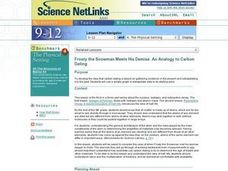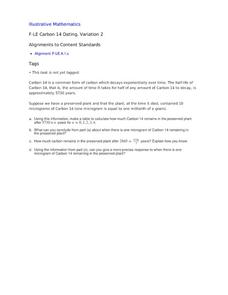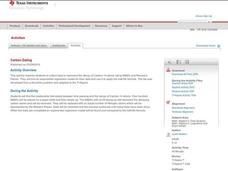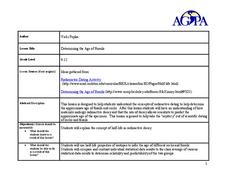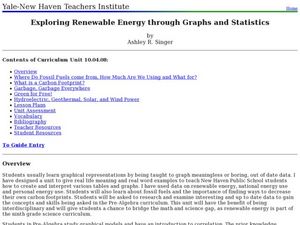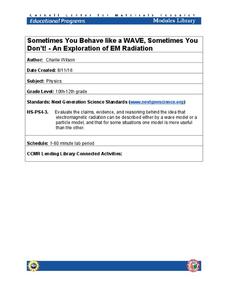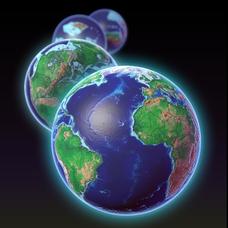Curated OER
Frosty the Snowman Meets His Demise: An Analogy to Carbon Dating
Students read and discuss an article about carbon dating, then participate in a hands-on lab to discover how carbon dating works. Students also write a letter to a friend explaining the process, and how archeologists use the process to...
Curated OER
Methods of Mystery
Students utilize the scientific method to discover the age of an item. In this historical dating lesson, students compare and contrast a 400 year old cabinet to one made within a few years by using carbon dating. Students complete a...
Curated OER
Carbon 14 Dating, Variation 2
Your archaeologists begin this task with a table of values to estimate the time passed based on the half-life of Carbon 14 remaining in a plant. They then move on to find when a specific amount of Carbon 14 is present in the same plant,...
Curated OER
Teaching Radioactive Decay: Radioactive Half-life And Dating Techniques
Students generate a radioactive decay table for an imaginary element using a box filled with pinto beans and M&M's. They use their data to plot a decay graph, develop the concept of half-life, and use the graph to "age" several samples.
Curated OER
Carbon Dating
Simulate C-14 decay using M&M and Reese's Pieces candies. In this scatter-plot lesson, students perform an experiment to simulate the half life of C-14. Information is plotted on a scatter-plot. Students answer four comprehension...
Curated OER
Carbon Usage and Offsets on Putnam City Campuses and Area Businesses
Students examine carbon output. In this climate change lesson, students plan and complete an assessment of local businesses and schools based on the carbon output of their electrical usage.
Curated OER
Space Shuttle Science
Students study the nomenclature, operation and purpose of America's Space Transportation system. They demonstrate how water can be broken down into its component gases of hydrogen and oxygen by electrolysis. They construct and use the...
Curated OER
Half Life Analogy
Eighth graders explain half life. In this hands on activity, 8th graders use licorice to explain radioactive decay and graph their results.
Curated OER
Determining the Age of Fossils
Students examine the concept of radioactive dating. In this radioactive dating lesson, students investigate how to determine the ages of fossils and rocks as they learn about half-life radioactive decay.
Curated OER
Identifying the Relationship Between Black Carbon and the Weather
Students identify the relationship between black carbon and the weather. In this investigative lesson students compare samples of black carbon with a color-scale and analyze others samples.
Curated OER
Current Earthquake Activity
Fifth graders record any earthquake activity throughout the school year on various maps. In groups, they identify a map locating the points given to them by their teacher. To end the lesson, they add the date, strength and damage to each...
Curated OER
Exponential Decay
Young scholars study exponential decay and its application to radiocarbon dating. In this exponential decay lesson, students use candy to model the time it takes for something to decay. Young scholars also graph the data they collect and...
Curated OER
Dinosaur I Finding And Dating
Students investigate how long dinosaurs lived on Earth and how that compare to how long man has been on Earth. They discover how scientists excavate fossils.
Curated OER
Exploring Renewable Energy Through Graphs and Statistics
Ninth graders identify different sources of renewable and nonrenewable energy. In this math lesson, learners calculate their own carbon footprint based on the carbon dioxide they create daily. They use statistics to analyze data on power...
Cornell University
Sometimes You Behave Like a WAVE, Sometimes You Don't!
Electromagnetic radiation behaves like both a wave and a particle. Help classes explore this concept through a lab investigation. Young scientists create optical interference patterns on a glass slide using a carbon layer. They analyze...
Curated OER
Half-Life Lab
Students participate in a lab in which they are introduced to carbon-dating. In groups, they use the holes of paper from a hole puncher and determine the rate of retention after shaking coins onto the same area. They record their...
Howard Hughes Medical Institute
EarthViewer
Can you imagine Washington DC and London as close neighbors occupying the same continent? Learners will be fascinated as they step back in time and discover the evolution of the earth's continents and oceans from 4.5 billion years ago to...
Curated OER
Experiment on Measuring Reaction Rates
High schoolers investigate the rate of a chemical reaction. In this rate of reactions lesson plan, students use an electronic balance to measure the change in mass of a chemical reaction between hydrochloric acid and calcium carbonate....
Curated OER
Bouncing Popcorn
Third graders meet a teacher challenge to work like chemists. They investigate with baking soda, water, salt, sugar, vinegar, and sprite to move a popcorn kernel from the bottom of a cup to the top. They experiment with different...
Curated OER
Revolving Shapes Around an Axis
Students design a wheel that could be used on a CO2 car. In this engineering instructional activity, students investigate cylinders and volume as they perform rotation around an axis. They create patterns using circular turns about an axis.
Curated OER
Chemical Composition of Everyday Objects
Students relate chemistry to an object they use everyday. They research information related to chemistry and create their own webpage. They are to keep their page up to date as new observations are taken.
Curated OER
Where Do Green Plants Get Energy?
Fourth graders realize that plants need light, water, and carbon dioxide to carry out photosynthesis. They participate in groups of 4 to plant (with materials provided) a test group of beans to compare to the control group, write a...
Curated OER
Properties of Matter
Ninth graders explore the molecular structure of matter and how it can affect the physical characteristics of a specific material. They demonstrate that isotopes of an element have different masses. Students demonstrate that the rates of...
Curated OER
How is Atomic Energy Used Today
Students investigate energy sources by examining photographs. In this atomic energy lesson, students identify and describe various pictures and how atomic energy is used in them. Students create a presentation demonstrating how many...
Other popular searches
- Carbon Dating M&m
- Carbon Dating Problems
- Carbon Dating Fossils
- Carbon Dating M
- Earth Science, Carbon Dating
- Radio Carbon Dating
- Simple Carbon Dating
- Earth Science Carbon Dating
- Carbon Dating Archaeology
- Fossil Dating Carbon
- Carbon Dating Archeology
- Carbon Dating M\&m


